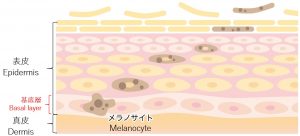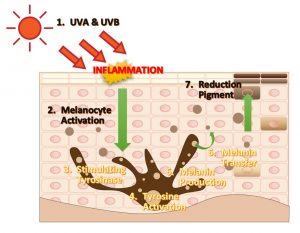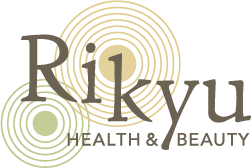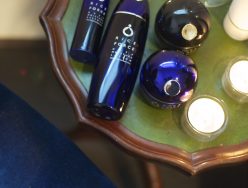7 Routes – how to treat pigmentation
Dedication and time are essential for treating pigmentation.
Environ’s founder Dr. Fernandez says “There are many important factors that need to be addressed, and no one magic ingredient can do it all” – Pigmentation is one of the most difficult skin concerns to care for.
Whether you use Environ or not, it should be helpful to have a basic knowledge of the skin why pigmentation can be appeared. The understanding of mechanism can help you in choosing right cosmetics and treatment to solve the problems.

In pigmentation, melanin secreted by melanocytes presented in the basal layer, which is the lowermost layer of the stratum corneum. The melanin is taken up by keratinocytes and normally metabolized by keratinisation. However, if it’s not completed and some are remained within the skin, it will show pigmentation.
In order to effectively reduce this blemishes, first of all, let’s look at the following “seven passage points” in the melanin production process.
- UV rays (UVA & UVB)
- Melanocyte activator
- Stimulating Tyrosinase
- Tyrosine activation
- Melanin production
- Melanin transfer
- Reduction pigment

Causes of pigmentation include various external/internal factors such as UV light, blue light, hypersecretion of hormones, medication, stress, smoking, etc. Of these, the biggest cause is the sun exposure. Blocking the sun light with sunscreen everyday is the most important in preventing further formation of unwanted marks.
Related article : Sunscreen to protect your skin from photo-aging
In addition, reducing oxidative stress generated by various factors including the UV light is indispensable to keep the skin healthy. Antioxidants and vitamins A, C, E can help to protects the healthy epidermis and minimizes further skin pigmentation.
Related article : Vitamin A for repairing and regenerating healthy skin
When skin is stimulated by various factors, “the melanocyte activator” is released in the epidermal cells to stimulate the melanocyte. The cell will receive this information and send a signal to create the melanin.
The first step in pigmentation skin care is to suppress the release of melanocyte activator and excessive signaling to melanocytes.
Tranexamic acid is said to inhibit plasmin, which is one of the melanocyte activators*。
In addition, it is reported that Geranium Robertianum Extract has the effect of suppressing the action of the enzyme tryptase, which can cause skin inflammation, and protecting the skin from photoaging.**、Biobenefity (Archchoke leaf extract) also has research showing that NF-κB present in epidermal cells suppresses excessive activity by stimulation with ultraviolet rays and has the effect of suppressing photoaging.*。
Regarding melanin activator, there are many studies on plant extracts, and we can expect future research reports.
To be completely different subject, even in the field of aromatherapy, an essential oil of Geranium (Pelargonium) has the highest anti-inflammatory effect on the skin*. Although Geranium Robertianum is a different spieces from Pelagonium, it finds interesting to shows the common action of anti-inflammatory in the same geranium family.
There are various possible melanocyte activators, so it would be difficult to block all of them even if they can be reduced, to some extent.
Tyrosinase is the most important enzyme involved in melanin production, and its secretion is activated by melanocyte activator.
Therefore, inhibition of over-secretion of tyrosinase is important as the most direct approach in the early stages of pigmentation pathway.
Even if you look over various brightening cosmetics, it is often included active ingredients to help inhibit the tyrosinase activity.
Arbutin is known as a component that suppresses melanin production by directly inhibiting tyrosinase activity.*。
There are α-Arbutin and β-Arbutin. However, it is said that α-Arbutin, which is a derivative formed by combining hydroquinone and glucose, has a better inhibitory tyrosinase activity than β-Arbutin.*。
Vitamin C is an essential ingredient for reducing pigmentation, as Vitamin C also has actions to suppresses early development factors thanks to its strong anti-oxidant and inhibitory tyrosinase activity*.
When tyrosinase is secreted, it binds to an amino acid called tyrosine in melanocytes and gradually changes its chemistry towards complete form of melanin.
Experimental results show that Sepiwhite (undecylenoylphenylalanine) is effective in reducing spots when mixed with Niacinamide*. This can inhibit α-melanocyte stimulating hormone and the activity of tyrosine in cells.
Tyrosine gradually changes to form and eventually becomes melanin.
Therefore, blocking this conversion route is also effective in preventing pigmentation.
Glycolic acid, lactic acid*, and vitamin C* have a melanin production inhibitory effect.
Vitamin C also has the effect of reducing the pigments created at this conversion process.*
Melanin made from melanocytes is transferred to keratinocytes through elongated branch-like processes called dendrites in melanocyte.
To prevent pigmentations, it is important to reduce this movement of this melanin.
Niacinamide is said to prevent excessive surfaceization of melanin by inhibiting this process of melanin transfer to keratinocytes.*
Melanin is essential component because it is manufactured to protect the skin from UV rays and other stimuli. The problem is that this melanin is made too much and stays in the skin.
In other words, reducing the pigment that has deposited on the stratum corneum will lead to reduce the pigmentation.
Hydroquinone has been shown to bleach the blemishes that have formed, as well as the tyrosinase inhibitory action.*
AHA acids such as lactic acid can increase skin turnover*, which encourage to deliver long-stayed pigments to the surface of the skin for reduction.
Repairing to a healthy skin with vitamins A, C, and E will also help reduce hyperpigmentation.
As mentioned all above, products including sunscreen as well as one that work on seven routes of the pigmentation formation, are essential to clear unwanted dark marks.
Be aware of selecting a product including active brightening ingredients, antioxidants, anti-inflammatory ingredients.
In order to make it work more effectively on the skin, it is also beneficial to look to use a facial devices and microneedles, and to take care of the inside the skin with food and supplements as well.







